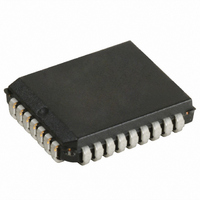CY7B991V-7JC Cypress Semiconductor Corp, CY7B991V-7JC Datasheet - Page 10

CY7B991V-7JC
Manufacturer Part Number
CY7B991V-7JC
Description
IC CLK BUFF SKEW 8OUT 32PLCC
Manufacturer
Cypress Semiconductor Corp
Series
RoboClock™r
Type
Buffer/Driverr
Datasheet
1.CY7B991V-2JC.pdf
(13 pages)
Specifications of CY7B991V-7JC
Number Of Circuits
1
Ratio - Input:output
8:8
Differential - Input:output
Yes/Yes
Input
3-State
Output
LVTTL
Frequency - Max
80MHz
Voltage - Supply
2.97 V ~ 3.63 V
Operating Temperature
0°C ~ 70°C
Mounting Type
Surface Mount
Package / Case
32-PLCC
Frequency-max
80MHz
Lead Free Status / RoHS Status
Contains lead / RoHS non-compliant
Other names
428-1384
Available stocks
Company
Part Number
Manufacturer
Quantity
Price
Company:
Part Number:
CY7B991V-7JC
Manufacturer:
Cypress Semiconductor Corp
Quantity:
10 000
Part Number:
CY7B991V-7JC
Manufacturer:
CYPRESS/赛普拉斯
Quantity:
20 000
Company:
Part Number:
CY7B991V-7JCT
Manufacturer:
Cypress Semiconductor Corp
Quantity:
10 000
skews to +6 t
figurations can be realized by skewing both the output used as the
FB input and skewing the other outputs.
Figure 4 shows an example of the invert function of the LVP-
SCB. In this example the 4Q0 output used as the FB input is
programmed for invert (4F0 = 4F1 = HIGH) while the other
three pairs of outputs are programmed for zero skew. When
4F0 and 4F1 are tied high, 4Q0 and 4Q1 become inverted zero
phase outputs. The PLL aligns the rising edge of the FB input
with the rising edge of the REF. This causes the 1Q, 2Q, and
3Q outputs to become the “inverted” outputs with respect to
the REF input. By selecting which output is connect to FB, it is
possible to have 2 inverted and 6 non-inverted outputs or 6
inverted and 2 non-inverted outputs. The correct configuration
would be determined by the need for more (or fewer) inverted
outputs. 1Q, 2Q, and 3Q outputs can also be skewed to com-
pensate for varying trace delays independent of inversion on
4Q.
Figure 5 illustrates the LVPSCB configured as a clock multipli-
er. The 3Q0 output is programmed to divide by four and is fed
back to FB. This causes the PLL to increase its frequency until
the 3Q0 and 3Q1 outputs are locked at 20 MHz while the 1Qx
and 2Qx outputs run at 80 MHz. The 4Q0 and 4Q1 outputs are
programmed to divide by two, which results in a 40-MHz wave-
form at these outputs. Note that the 20- and 40-MHz clocks fall
Document #: 38-07141 Rev. **
20 MHz
Figure 5. Frequency Multiplier with Skew Connections
Figure 4. Inverted Output Connections
FB
REF
FS
4F0
4F1
3F0
3F1
2F0
2F1
1F0
1F1
TEST
FB
REF
FS
4F0
4F1
3F0
3F1
2F0
2F1
1F0
1F1
TEST
U
, a total of +10 t
4Q0
4Q1
3Q0
3Q1
2Q0
2Q1
1Q0
1Q1
4Q0
4Q1
3Q0
3Q1
2Q0
2Q1
1Q0
1Q1
REF
U
skew is realized.) Many other con-
REF
7B991V–11
7B991V–12
40 MHz
20 MHz
80 MHz
simultaneously and are out of phase on their rising edge. This
will allow the designer to use the rising edges of the
quency and
ing-edge skew. The 2Q0, 2Q1, 1Q0, and 1Q1 outputs run at
80 MHz and are skewed by programming their select inputs
accordingly. Note that the FS pin is wired for 80-MHz operation
because that is the frequency of the fastest output.
Figure 6 demonstrates the LVPSCB in a clock divider applica-
tion. 2Q0 is fed back to the FB input and programmed for zero
skew. 3Qx is programmed to divide by four. 4Qx is pro-
grammed to divide by two. Note that the falling edges of the
4Qx and 3Qx outputs are aligned. This allows use of the rising
edges of the
for skew mismatch. The 1Qx outputs are programmed to zero
skew and are aligned with the 2Qx outputs. In this example,
the FS input is grounded to configure the device in the 15- to
30-MHz range since the highest frequency output is running at
20 MHz.
Figure 7 shows some of the functions that are selectable on
the 3Qx and 4Qx outputs. These include inverted outputs and
outputs that offer divide-by-2 and divide-by-4 timing. An invert-
ed output allows the system designer to clock different sub-
systems on opposite edges, without suffering from the pulse
asymmetry typical of non-ideal loading. This function allows
the two subsystems to each be clocked 180 degrees out of
phase, but still to be aligned within the skew spec.
The divided outputs offer a zero-delay divider for portions of
the system that need the clock to be divided by either two or
four, and still remain within a narrow skew of the “1X” clock.
Without this feature, an external divider would need to be add-
ed, and the propagation delay of the divider would add to the
skew between the different clock signals.
These divided outputs, coupled with the Phase Locked Loop,
allow the LVPSCB to multiply the clock rate at the REF input
by either two or four. This mode will enable the designer to
distribute a low-frequency clock between various portions of
the system, and then locally multiply the clock rate to a more
suitable frequency, while still maintaining the low-skew charac-
teristics of the clock driver. The LVPSCB can perform all of the
functions described above at the same time. It can multiply by
two and four or divide by two (and four) at the same time that
it is shifting its outputs over a wide range or maintaining zero
skew between selected outputs.
20 MHz
Figure 6. Frequency Divider Connections
FB
REF
FS
4F0
4F1
3F0
3F1
2F0
2F1
1F0
1F1
TEST
1
1
4
2
frequency and
frequency outputs without concern for ris-
4Q0
4Q1
3Q0
3Q1
2Q0
2Q1
1Q0
1Q1
REF
1
4
3.3V RoboClock
frequency without concern
CY7B991V
Page 10 of 13
10 MHz
20 MHz
5 MHz
7B991V–13
1
2
fre-














